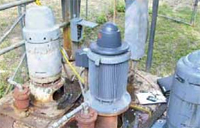 Basically, a repair is the simplest, least-involved way of "fixing" a pump, typically caused by a non-recurring accidental event, such as a broken shaft, failed seal, and so on. An overhaul is more involved. It may include changeover of all the bushings and shafts, reestablishing register fits, restoring impeller clearances, and similar work. An upgrade will include repair and overhaul work, but typically also includes hydraulic modifications to change pump performance - to increase or decrease flow, shift best efficiency point, change materials of construction, etc.
Basically, a repair is the simplest, least-involved way of "fixing" a pump, typically caused by a non-recurring accidental event, such as a broken shaft, failed seal, and so on. An overhaul is more involved. It may include changeover of all the bushings and shafts, reestablishing register fits, restoring impeller clearances, and similar work. An upgrade will include repair and overhaul work, but typically also includes hydraulic modifications to change pump performance - to increase or decrease flow, shift best efficiency point, change materials of construction, etc.
Last month we explored some of the highlights in the repair process of horizontally split pumps. Now let's talk about vertical turbine pumps. First of all, what is the difference between a repair, an overhaul and an upgrade?
Basically, a repair is the simplest, least-involved way of "fixing" a pump, typically caused by a non-recurring accidental event, such as a broken shaft, failed seal, and so on. An overhaul is more involved. It may include changeover of all the bushings and shafts, reestablishing register fits, restoring impeller clearances, and similar work. An upgrade will include repair and overhaul work, but typically also includes hydraulic modifications to change pump performance - to increase or decrease flow, shift best efficiency point, change materials of construction, etc.
Right from the beginning, clearly understanding which of these procedures is called for and why is very important because the extension, quality and price of work vary greatly depending upon what will be done to the pump. Scope of work creates a source of constant misunderstanding and frustration among the pump user community, as well as for repair shops.
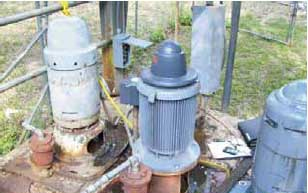 For example, a higher-price bidder may lose an order due to simply misunderstanding the expectations of the pump end user. His quote to restore all register fits requires the use of expensive machinery (high price), while all the end user might want is to change a leaky seal and return the pump back to service as quickly as possible.
For example, a higher-price bidder may lose an order due to simply misunderstanding the expectations of the pump end user. His quote to restore all register fits requires the use of expensive machinery (high price), while all the end user might want is to change a leaky seal and return the pump back to service as quickly as possible.
The need for a pump repair is established essentially from one of the three scenarios:
Figure 1. Foundations do not look too good. All you can typically see is a motor and a support head; it is difficult to know what is under it. In this example, note that there are no anchor bolts, and the sole plates do not even have holes for the anchors drilled in it. A spirit alone is holding the pumps down.
a. Problems with a pump (noise, vibrations, leaks, lost performance, etc. or downright failure) - typically (although not always) a "reactive" approach, with run-to-failure mentality being a prevalent culture of the plant.
b. Accumulated run time (10 to 15 years) and gradual deterioration of performance - a more "proactive" approach, typically applied by more reliability-conscious organizations.
c. A combination of (a) and (b) above.
In case (a), a repair shop is called (often on emergency) to pull the pump and fix it. Due to the urgency of the situation, competitive quotes are often either limited or bypassed entirely and repairs are performed by whatever shop performed some repairs in the past.
For vertical pumps, all that is visible is a support head and a motor, with the rest of the pump under the sole plate, as shown in the example photo in Figure 1.
From this, a "rough" quotation is then based strictly on past experience with similar units and typically contains:
- Disassembly, blast and clean
- Replacement of (some) bearings (bushings) and packings
- Replacement (or repair) of mechanical seals
- Reassembly, paint and delivery back to the customer
The quotation covering the scope of work listed above looks good to a purchasing department seeking a low bid, but it does not address the maintenance concerns of repeated failures. Typically, no repair report, no root cause analysis, and no pre-repair vibrations analysis accompany this sort of expedited repair job and, sure enough, there is little surprise when the same (low bid) repair is repeated again one to three years later.
A more "sophisticated" bidder will get an award based on the minimum amount of quoted work (as listed above), but when the pump is actually reassembled in the shop, the bidder will submit price additions for replacing the broken shaft(s), changing the wear rings, weld repairs, epoxy coat to improve efficiency, and so on.
These additions may dwarf the original quote, but by that time all of the initial competitive bidders are gone. The shop that already has the pump ends up completing the extended scope of work. As many folks know, "bait-and-switch" is an appropriate name for this sort of strategy.
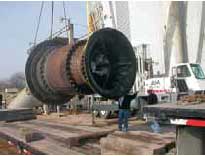 To clarify and unify expectations, a good starting point is to have a 3-level set of specifications prepared for the vertical turbine pump repair/overhaul/upgrade work. These are:
To clarify and unify expectations, a good starting point is to have a 3-level set of specifications prepared for the vertical turbine pump repair/overhaul/upgrade work. These are:
Level 1
Basic repair (a simplified sample is essentially shown above, and each plant can modify for particular needs and specifics). A limited report or documentation of internals, such as clearances, etc. is provided for this level.
Level 2
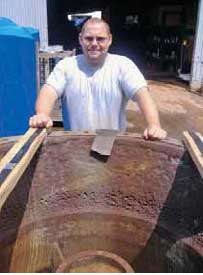 Extended repair:
Extended repair:
- Disassemble, blast and clean
- Document critical dimensions and clearances at as-found condition, shafts run-outs; provide photos and sketches of critical components with comments pointing to (possible) root cause(s)
- Replacement of bearings (bushings), packings and interstage couplings
- Replacement or straightening of shafts with documented method of strengthening
- Replacement of mechanical seals
- Restoring clearances between impeller(s) and case liner(s)
- Epoxy coat impeller, bowls and piping
- Reassembly, paint and delivery back to the customer
Level 3
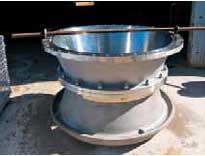 Complete overhaul:
Complete overhaul:
- All Level 2 steps
- Reline cones martensitic stainless steel liner and rework impeller vanes to match the cone angle and restore proper clearances
- Remachine all fits between mating parts to ensure parallelism and perpendicularity of the entire rotor
- Repair of the suction bell
- Provide a complete report stating as-found and final dimensions and all critical clearances
- Pre- and post-overhaul vibration analysis (and flow analysis as an option) to assess effectiveness of the overhaul
In addition, any upgrades (such as changing from a 4140 to 416 SS shaft, or from a bronze to stainless impeller, etc.) must be added at the quotation stage. Such upgrades should be pre-planned in advance, not left as an on-the-spot shop decision.
If a job is quoted as a turnkey, removal and reinstallation of the pump, motor, and any site dress-up work should be identified in the original quotation, but listed as a separate item.
Within the next several months, we plan to gather reader feedback, comments and questions, with the objective of developing a Proposed Draft of the Procedure of the Repairs and Upgrades of vertical turbine pumps. Let us know what you think and share your own experience and any issues/challenges you might have encountered (as many others have) in handling these issues. Your input is appreciated - and will contribute to make history. This article is just a brief starting point. Come aboard!
Pumps & Systems, January 2008


